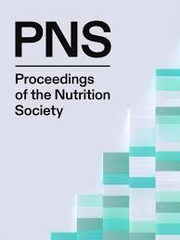No CrossRef data available.
Article contents
Association of temporal protein patterns with diabetes and glycemic measures
Published online by Cambridge University Press: 09 October 2025
Abstract
Previous studies suggest a link between protein intake and diabetes,(1,2) but little is known about whether protein intake timing across the day (i.e. temporal protein patterns) is associated with diabetes. This study aimed to examine temporal protein patterns in American adults and their associations with diabetes, BMI and glycemic measures.
Total protein intake at eating occasions was estimated from the National Health and Nutrition Examination Survey 2017-2020 dietary recall data (≥20 y; n=7625). Latent variable mixture models were used to identify temporal patterns based on hourly protein intake (g). Adults with fasting glucose ≥7.0 mmol/L, poor glycemic control (HbA1c ≥6.5%), taking diabetic medications, or previous diabetes diagnosis were classified as having diabetes. Insulin ≥72 pmol/L and HOMA-IR ≥2.5 were used to determine hyperinsulinemia and insulin-resistance, respectively. Regression models were used to examine associations for temporal protein patterns with diabetes prevalence, BMI and glycemic measures (fasting glucose, HbA1c, insulin, Homeostatic Model Assessment of Insulin Resistance), adjusted for multiple confounders.
Three latent classes for men’s and women’s temporal protein patterns were identified. Class 1 had higher conditional probabilities of eating protein at 18:00h, while Class 2 tended to eat protein an hour later than Class 1 and had higher overall protein intake (p<0.001). Class 3 was characterised by variable protein intake timing and had lower overall protein intake than the other classes (p<0.001). Men’s Class 1 had lower probabilities for hyperinsulinemia (32.5%) and poor glycemic control (5.9%), but associations were attenuated after adjusting for BMI. There were no associations for temporal protein patterns with diabetes, BMI and other glycemic measures.
Temporal protein patterns were not associated with diabetes. The inverse association with several glycemic measures observed for men in Class 1 may be mediated by BMI. Future prospective studies may better examine the effects of temporal protein patterns on diabetes by considering different protein food sources.
Information
- Type
- Abstract
- Information
- Proceedings of the Nutrition Society , Volume 84 , Issue OCE4: Nutrition Society Conference 2025, 1-2 July 2025 , August 2025 , E297
- Copyright
- © The Author(s), 2025. Published by Cambridge University Press on behalf of The Nutrition Society


